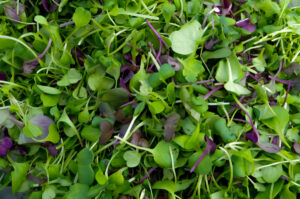I scream, you scream, we all scream for microgreens! Ok, maybe not, but we should!
Research has shown a microgreen has between 4- and 40-times higher levels of vital nutrients than their mature counterparts depending on the variety. Plus, they are packed with flavor, come in a variety of textures, and colors making them delicious and beautiful on the plate. They are rich in potassium, iron, zinc, magnesium, copper, and are also an excellent, concentrated source of antioxidants.

What are microgreens?
If sprouts are the babies of the plant world, microgreens are the toddlers. They are vegetable plants with edible leaves, approximately 1-3 inches tall, and 7-21 days into their life cycle. These young plants are gearing up to grow so they are chocked full of nutrients. This means that it doesn’t take much to pack a punch of flavor and nutrition.
How do I prepare microgreens?
Since they are delicate baby plants, they should not be cooked. Their beauty and pop of flavor are meant to be sprinkled, placed or combined right before serving.
The first step is washing which should be done carefully. They are full of water already, and should not be drowned. Rinse them lightly and dry with paper towel or with a salad spinner.
Now you can let your imagination run wild, combine into sandwiches, wraps, salads, and dips. They are also good as a last-minute topping to cooked pizzas, soups, omelets, pastas, and even sushi. Smoothies are also great vessels for delivering a microgreen punch. Wheatgrass is a microgreen, and it is a legendary smoothie ingredient.
Recipes:
Where do I get them?
At one point they were an item for chefs and restaurants only, but thanks to emergence of aeroponic, and hydroponic farms they are readily available at farmers markets, and in grocery stores. Microgreens are also an excellent option to grow in a Tower Garden.
https://youtu.be/47Iv2DPHZZg
Common Types of Microgreens:
- Brassicaceae family: Cauliflower, broccoli, cabbage, watercress, radish and arugula
- Asteraceae family: Lettuce, endive, chicory and radicchio
- Apiaceae family: Dill, carrot, fennel and celery
- Amaryllidaceae family: Garlic, onion, leek
- Amaranthaceae family: Amaranth, quinoa swiss chard, beet and spinach
- Cucurbitaceae family: Melon, cucumber and squash
